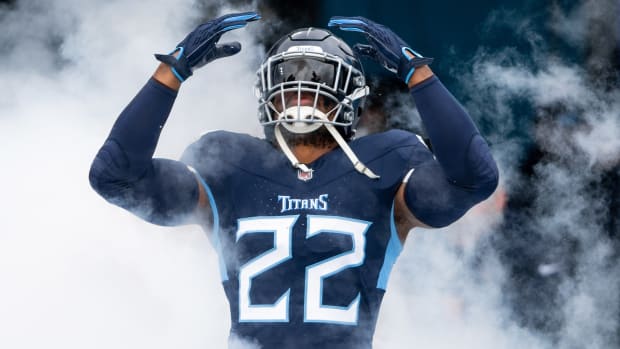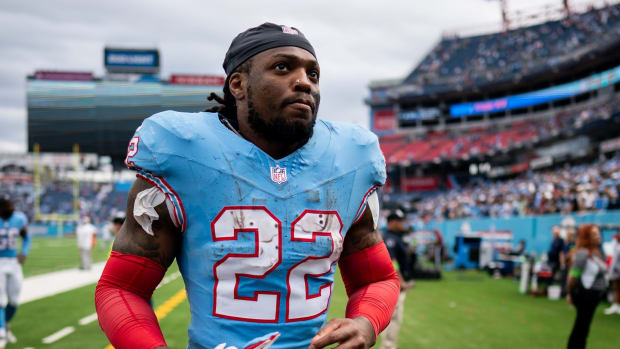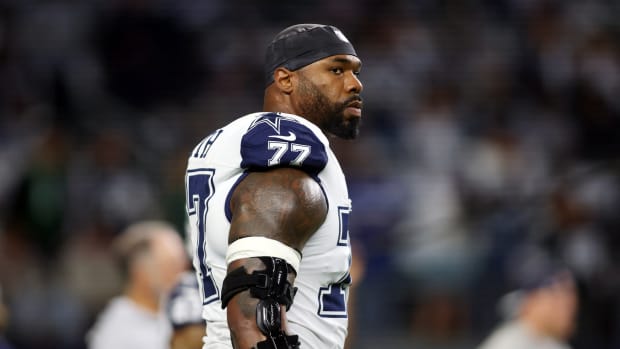Breaking Down the Rise in Henry's Receiving Numbers
NASHVILLE – Stymied by stacked boxes and six-man defensive fronts, Derrick Henry has looked like a mere mortal in the running game over the past three weeks.
The Tennessee Titans’ All-Pro back has averaged just 2.8 yards on his 64 attempts during that stretch, failing to produce a single run of more than 10 yards.
But that doesn’t mean the big man has been completely silenced.
In fact, Henry is racking up receiving yards like never before.
Thanks to his 69-yard catch in last Sunday’s loss to Cincinnati and a 42-yard reception against Green Bay the previous week, Henry is coming off the best back-to-back receiving games of his seven-year career – a combined five catches for 124 yards.
He’s not been just a two-week wonder in the passing game either.
Eleven games into the 2022 season, Henry has already recorded career-best numbers for receptions (21) and receiving yards (278).
Why the big step forward this year?
Henry explains it as simply the byproduct of continued repetition.
“I think just coming out here and working on it – me and (running backs coach Tony Dews) work on it a lot through practice, and just having a heavy emphasis on it,” Henry said. “It’s something I want to get better at, and just constantly work at it.”
But Dews offered more insight into why Henry has been more productive catching passes than ever before.
Here are some of the ways he detailed Henry’s evolution as a receiver:
Making the quarterback’s job easier
The easier one makes the quarterback’s job, the more likely he is to throw you the ball.
Henry has become more aware of how he fits in the passing game, which in turn has helped him gain the trust of quarterback Ryan Tannehill.
“He’s doing a better job of where he’s supposed to be conceptually, understanding what his job is and the big picture of the concept,” Dews said. “Really the big thing is understanding where you’re supposed to be, and then – I talk to him all the time about it – just be available for the quarterback. There are some little nuances in terms of when you see (linebackers playing zone), where to snap down in a certain window and find those holes in zones and things like that.
“I think he’s improving that way, and just like anything else, when (Tannehill) gets off his initial reads and needs to find a completion, (Henry and other Titans backs) have all done a nice job of being in the right place. They’ve been able to help the quarterback when he needs it.”
Spacing and separation
Many of Henry’s catches are either behind or right around the line of scrimmage, so he’s unlikely to gain huge separation prior to the reception.
Still, his improved route running has helped him gain an extra split second after the catch – or helped create more space for a teammate to make a reception.
“It’s about understanding the spacing of the concepts and being where you’re supposed to be,” Dews said. “Instead of just kind of trickling and jogging out (into a route), it’s knowing that if I get out here, I’m going to force a defender to either cover me or he’s going to sink and cover the route behind him. So (Henry’s) understanding that if I get out here with a certain speed and into an area, it’s either going to be open for me to catch and run, or (the defender) is going to come to me and I’m going to open someone else up.”
Bringing it in
Henry has never been a natural pass-catcher, and that part of his game remains a work in progress. He has four dropped this season, per Pro Football Focus, tied for fourth-most among league running backs. But Dews likes the willingness Henry has shown to better himself in that aspect of the game.
“In terms of the physical part of the game, he’s done a nice job with his eyes,” Dews said. “(Coach Mike Vrabel) talks all the time about catching the ball out in front of your eyes, and that’s reaching and catching the ball out in front of you and hand placement, things like that. I think he’s improved in that aspect.
“Then there’s the catch transition, from catch to tuck to how quickly I can transition into a runner. We talk about that. (Henry) understands that and he works at that, so I think that’s been helping a little bit, too.”
Yards after catch
It takes the 6-foot-3, 247-pound Henry a couple of steps to build up steam, but once he does, watch out.
As Dews referenced earlier, Henry has done a better job this year of finding a little more space before he makes the catch, and a little quicker job of transitioning from receiver to runner.
Those are two of the primary reasons he’s been able to produce big plays in the passing game. He’s averaging a career-best 13.4 yards after the catch this season, per PFF, the highest figure among any back with at least 10 receptions.
It’s a huge leap from 2021 (9.2 yards-after-catch average) and 2020 (6.3 yards-after-catch average).
“We know that if he can catch the ball cleanly and get running in some space,” Dews said, “he has a chance to get a first down or much more.”





